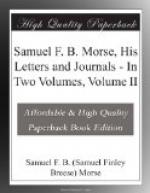This reason is not to make himself younger, but to appear to children and grandchildren more suitably matched as to age with their mother and grandmother.
If Mr. Morse is at leisure and disposed to undertake this work, he will please prepare his canvas and let me know when he is ready for my attendance.
NEW HAVEN,
30th March, 1823.
Whether Morse succeeded to the satisfaction of Mr. DeForest does not appear from the correspondence, but both this portrait and that of Mrs. DeForest now hang in the galleries of the Yale School of the Fine Arts, and are here reproduced so that the reader may judge for himself.
[Illustration: MR. D.C. DE FOREST MRS. D.C. DE FOREST From “Thistle Prints.” Copyright Detroit Publishing Co. From a painting by Morse now in the Gallery of the Yale School of the Fine Arts]
On the 17th of May, 1828, the first number of the New York “Observer” was published. While being a religious newspaper the prospectus says it “contains also miscellaneous articles and summaries of news and information on every subject in which the community is interested.”
This paper was founded and edited by the two brothers Sidney E. and Richard C. Morse, who had abandoned respectively the law and the ministry. It was very successful, and became at one time a power in the community and is still in existence.
The editorial offices were first established at 50 Wall Street, but later the brothers bought a lot and erected a building at the corner of Nassau and Beekman Streets, and that edifice had an important connection with the invention of the telegraph. On the same site now stands the Morse Building, a pioneer sky-scraper now sadly dwarfed by its gigantic neighbors.
The year 1823 was one of mingled discouragement and hope. Compelled to absent himself from home for long periods in search of work, always hoping that in some place he would find enough to do to warrant his bringing his family and making for them a permanent home, his letters reflect his varying moods, but always with the underlying conviction that Providence will yet order all things for the best. The letters of the young wife are pathetic in their expressions of loneliness during the absence of her husband, and yet of forced cheerfulness and submission to the will of God.
On the 17th of March, 1823, another child was born, a son, who was named for his maternal grandfather, Charles Walker. The child was at first very delicate, and this added to the anxieties of the fond mother and father, but he soon outgrew his childish ailments.
Morse’s active mind was ever bent on invention, and in this year he devised and sought to patent a machine for carving marble statues, “perfect copies of any model.” He had great hopes of pecuniary profit from this invention and it is mentioned many times in the letters of this and the following year, but he found, on enquiry, that it was not patentable, as it would have been an infringement on the machine of Thomas Blanchard which was patented in 1820.




